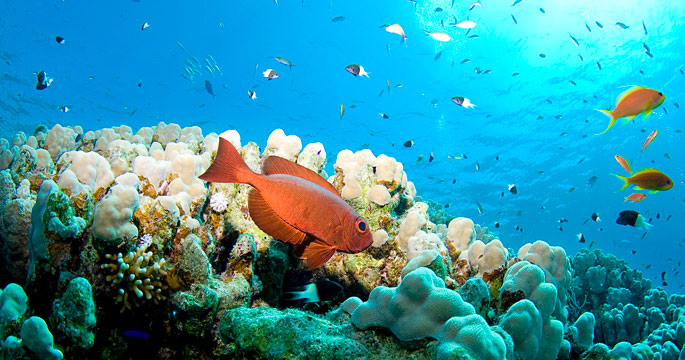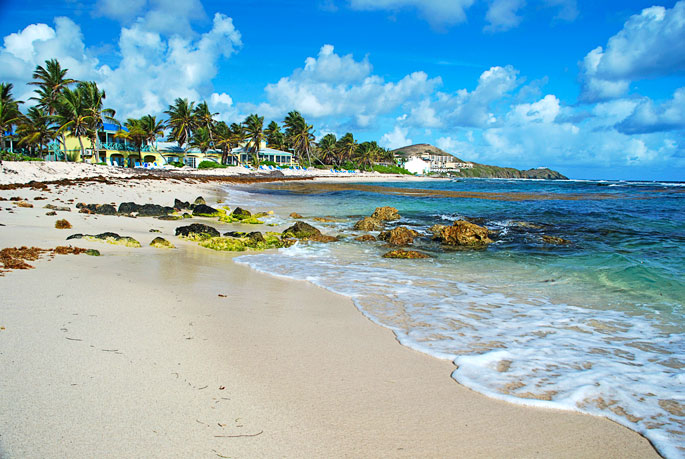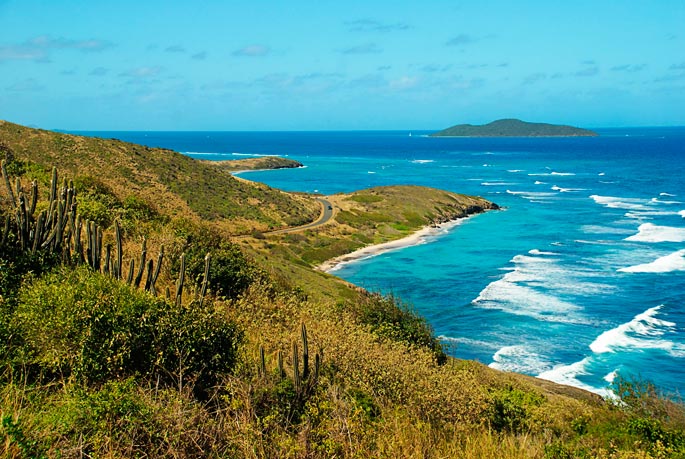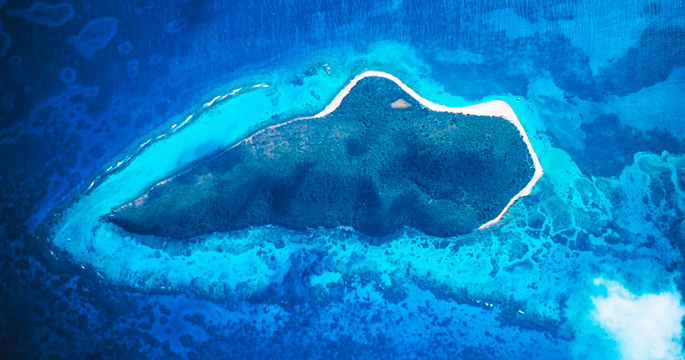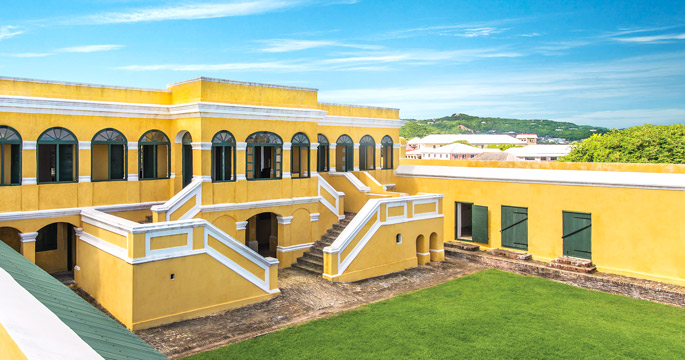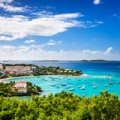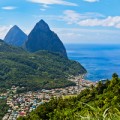Often called the sleeping virgin, St. Croix is the largest of the United States Virgin Islands, yet the least visited. This means there’s plenty of elbow room to wander the national parks and historic sites, and a table with a water view is always waiting at Christiansted’s taverns. You’ll even be able to find a secluded spot on one of the many beaches that ring the island.
1 Coral Wonderland
One of the Caribbean’s finest coral gardens lies just offshore of St. Croix. Buck Island Reef National Monument is a protected underwater park that’s part of the U.S. National Park Service. The 176-acre island is fringed by a 704-acre reef system rich with elkhorn coral groves that form interlacing channels and sun-dappled grottoes alive with colorful tropical fish and waving sea fans. Interpretive plaques identify the various types of coral, the marine habitats and the fish that swim by. Directional arrows lead the way through the coral maze. Topside, the sandy shores of Turtle Beach double as a nesting area for hawksbill turtles and a rookery for frigates and brown pelicans. Hike the nature trail to the crest of the hill for panoramic water views, then back to the sandy shores and throw down a towel for some time in the sun.
2 The Way It Was
Take a trip back in time at the seven-acre waterfront of Christiansted’s National Historic Site, which still resembles a Danish seaside town of the 18th or 19th century. Here, a collection of five sun-dipped historic buildings remain intact and ready for inspection. Fort Christiansvaern guards the harbor, complete with dungeons, ramparts and cannons. The nearby Scale House once regulated trade and collected duties for the crown, while the namesake spire of the Steeple Building guided mariners into port. Both are open for self-guided tours. Also not to be missed are the Danish Custom House and the Danish West India & Guinea Company Warehouse, which now doubles as a courthouse and post office.
3 Sunset and All That Jazz
Sunset views and jazz come together on the third Friday of each month in the seaside town of Frederiksted on the island’s southwest coast. Rebuilt after a massive fire in 1878, the town shows off its Victorian architecture with gingerbread-laced front porches wrapped in purple bougainvillea. Gather up your friends and family, some blankets and lawn chairs and find your spot at Frederiksted Beach just north of the pier. Local and international jazz musicians begin playing at 5:30 p.m. and continue on until sunset.
4 Footsteps of Columbus
Columbus landed at Salt River in 1493 while looking for freshwater deposits, and instead found the not-so-friendly Caribe Indians. Today Salt River Bay National Historical Park and Ecological Preserve is explored by a different type of adventurer; kayakers paddle around mangrove forests and over coral reefs that are home to many rare and endangered species. If you are lucky, you might spot a hawksbill turtle or the roseate terns that roost here. Take a moonlight guided tour and watch the water light up with bioluminescence.
5 A Reason to Party
In addition to the island’s annual winter Carnival, The town of Christiansted blocks the streets four times a year for Jump Up, a cultural festival that’s a celebration of food, dance and music. Mocko Jumbies, traditional stilt dancers that ward off evil, parade through the streets while shops and restaurants stay open late. Vendors set up stalls along the boardwalk and sell local cuisine, artwork and jewelry while the music of the steel drum lingers in the background.
6 No Passport and Duty-Free
Direct flights from the East Coast and no passport or visa requirements for U.S. citizens make a quick weekend getaway easy. Pack light and add to your collection of tropical wear while you are there. U.S. citizens can bring back up $1,600 in duty-free goods without paying an import tariff, and locally made items like artwork, jewelry and clothing are also free of sales tax. Both Cruzan Rum and Captain Morgan’s Rum are island-made, so plan on stocking up the liquor cabinet as well.
7 Grass Roots
St. Croix embraces its agricultural roots with an annual fair and mango festival. The island, once known as the breadbasket of the region, is seeing a rebound in small-plot and organic farming. Nestled into the rainforest on the island’s northwest corner, the Ridge to Reef Farm practices sustainable agriculture and provides the local community with healthful produce. Weekly tours, overnight working stays and volunteer programs are offered for those seeking to learn about farm life on a tropical island or maybe spend a few days working in the fields.
8 Wine and Dine, Island Style
An island of foodies, St. Croix has its fair share of celebrated chefs and varied cuisines. The culture harbors a widespread fascination with food: its history, preparation and presentation. And drink is not far behind. First launched in the year 2000, the St. Croix Wine and Food Experience has grown into a top-rated international food festival that attracts globetrotting epicureans. During the week-long event, held every April, celebrity chefs host intimate Cork & Fork dinners paired with wines in private homes. Other highlights include wine tastings from credentialed sommeliers, chef competitions, sunset barbecues and progressive dinners in Christiansted’s old town. The signature event is Taste of St. Croix, a night of sampling that brings together the culinary offerings of more than 50 island restaurants, chefs, farms and caterers.
9 Get Hooked
St. Croix is noted for its jewelry arts, and nothing says a visit to the island like a hook bracelet. This Cruzan icon was originally designed by Sonja Hough more than 40 years ago and has since been duplicated by many. You can find examples cast in gold or silver, with or without stones. Whatever the form, the message is all about love. Wear it with the open end of the hook pointed up toward your heart to signify you are taken. With the open end of the hook worn down, away from your heart, the message is that you are unattached or single.
10 Turtle Watch
The peninsula of Sandy Point National Wildlife Refuge is the longest and most pristine stretch of beach in the U.S. Virgin Islands. This beach is the largest leatherback turtle nesting site in the U.S. and remains off limits to humans from May to September. The site is managed by the U.S. Fish and Wildlife Department, which does allow human visitation on Saturday and Sunday during off-nesting months. This refuge is also a prime location for bird-watching, so be sure to pack a pair of binoculars and be on the lookout for brown pelicans, black- necked stilts and yellow warblers.

